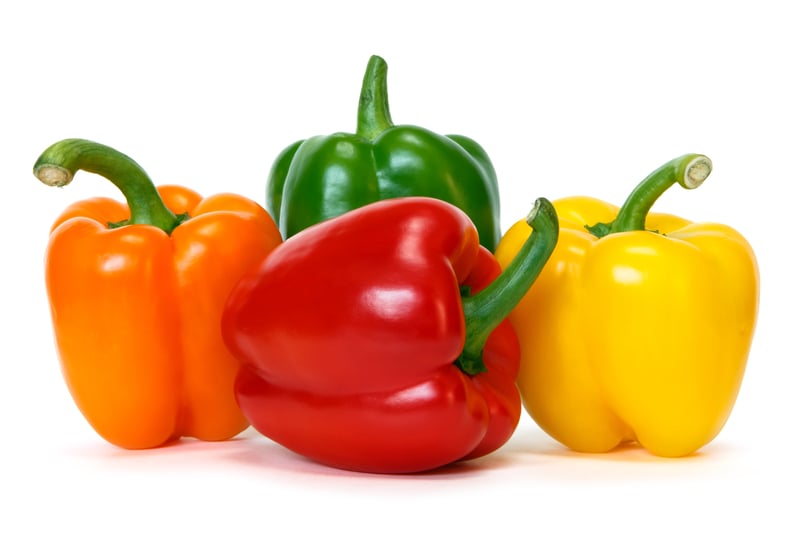What Color Bell Pepper Is the Healthiest for You?

With vivid reds, yellows, greens, oranges, and sometimes purple and even white, bell peppers (aka sweet peppers) add color and nutrition to just about any recipe. These versatile vegetables can be added to salads, soups, skillets, casseroles, and so much more. They can be enjoyed raw, cooked, or even pickled. Plus, you can often find bags that provide multiple variations. When taking your pick, do you just grab whatever color looks best, or do you wonder what color bell pepper is the healthiest? (It can’t just be me.)
Pepper Breakdown
Bell peppers all come from the same plant. The difference in colors varies depending on the stage of ripening. Yep, all of these peppers start out as green (unripe) and then ripen to the other colors. And these changes cause subtle alternations in flavor, sweetness, and nutrition levels.
All peppers have the same macronutrient profile. Per 3.5 ounces (100 grams), you’ll get 31 calories, 1 gram of protein, 6 grams of carbohydrates with 4.2 grams of natural sugars and 2.1 grams of fiber, and .3 grams of fat. So, per calorie, they’re a high-fiber food. They’re also a hydrating vegetable as they’re over 70% water. Finally, they’re all high in vitamin C, antioxidants, and phytonutrients, but that’s also where they differ.
For instance, when it comes to vitamin C, green peppers provide around 80 mg, yet yellow peppers have more than twice the vitamin C content at 184 mg. Both versions, it should be noted, are high in vitamin C. All bell peppers also provide vitamin B6, vitamin K1, potassium, folate, vitamin E, and vitamin A.
One of the other reasons for the variation in color of the ripening peppers is the carotenoids the pepper contains. Carotenoids affect the plant pigment (i.e., color) as well as nutrients.
For instance:
- Red peppers are higher in beta-carotene while yellow peppers have only small amounts. Red peppers also provide more of the antioxidant capsanthin.
- Yellow peppers, on the other hand, are higher in another antioxidant carotenoid called violaxthin.
- Orange peppers provide a good dose of lutein and zeaxanthin, which are carotenoids that are well-known for promoting eye health.
- Green peppers are also high in lutein. Other carotenoids found in peppers include quercetin and luteolin, which are both powerful antioxidants.
Bell peppers of all colors are a nutrient-dense plant food that provides a range of health benefits, including eye health and helping prevent anemia, especially when consumed with iron-rich foods like meat or spinach.
LIMITED TIME OFFER: Get Ageless Turmeric, Our Highly-Bioavailable Turmeric & Ginger Supplement, As Low As $14
Some people do note that green peppers, which are technically unripe, tend to be slightly bitter and lack the sweetness of ripe peppers. They’re also typically the most affordable variety. Red bell peppers are often considered the sweetest and also provide the highest amounts of vitamins A and C.
So, What Color Bell Pepper Is the Healthiest?
All colors of bell peppers are nutritious, low in calories, and provide a delicious, almost sweet crunch. Why choose? Grab the rainbow-colored bag and enjoy the benefits of any or all of them.



 7 Signs Your Body is Seriously Low on Collagen (not just wrinkles)
7 Signs Your Body is Seriously Low on Collagen (not just wrinkles) Health Expert: "Turmeric Doesn't Work (unless...)"
Health Expert: "Turmeric Doesn't Work (unless...)" 3 Warning Signs Your Probiotic Supplement is a Total Waste
3 Warning Signs Your Probiotic Supplement is a Total Waste

